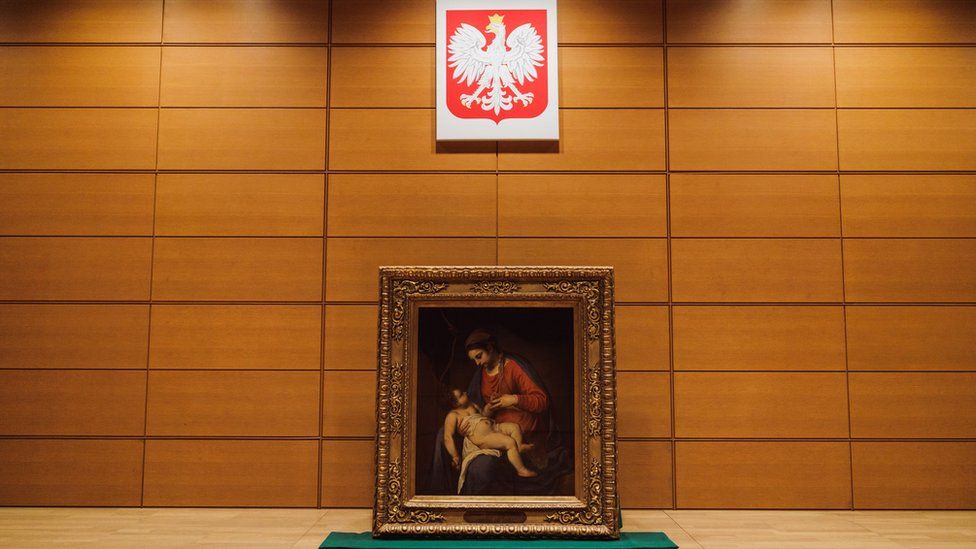ARTICLE AD BOX
 Image source, Polish Institute in Tokyo
Image source, Polish Institute in Tokyo
Madonna with Child has finally been returned to Poland
When the Nazis occupied Poland in World War Two, many of the country's priceless pieces of art were stolen.
One of those was Madonna with Child, a 16th Century painting attributed to Italian Alessandro Turchi. A Nazi official who oversaw the looting of art included the painting on a list of hundreds taken from occupied Poland.
But the painting is finally returning home, after being discovered in Japan and handed over to Polish authorities during a ceremony in Tokyo this week.
It is one of 600 looted artworks that Poland has managed to successfully bring home, but more than 66,000 so-called war losses are yet to be recovered.
Poland recently launched a campaign seeking the return of hundreds of thousands artworks and other cultural items still missing after German and Soviet occupations in World War Two. It is also seeking $1.3 trillion in reparations from Germany for damage incurred by occupying Nazis.
Experts believe more art will be discovered with the passage of time as heirs to looted artwork attempt to sell pieces without being aware of their history.
Madonna with Child is thought to have been transferred to Germany in 1940 during the Nazi occupation of Poland. The Nazis often looted art belonging to Jewish families before killing them.
The painting was included on a list of 521 artworks in occupied Poland compiled by Kajetan Mühlmann, a Nazi official who oversaw the looting of art.
The painting reappeared in the 1990s, when it was sold at a New York auction.
It was due to be auctioned in January last year, but the sale was halted after Polish authorities spotted the piece. Once it was proven to be the looted painting, the auction house and the painting's owner agreed to return it to Poland. An official handing-over ceremony took place in Tokyo on Wednesday.
Polish art historian Natalia Cetera said the return of masterpieces like Madonna with Child help restore pride in the country's art heritage.
Poland had Rembrandt and Raphael pieces stolen, as well as internationally recognised Polish masterpieces, she said.
"So whenever there is this situation where the artworks come back to Polish collections, you feel proud because it shows the importance of Polish collections that is sometimes forgotten," Ms Cetera told the BBC.
"It means we have some strong focus on remembering our heritage, our collections and the strength we used to have in art, because this is something we tried to rebuild after the war and this is a long process to be recognised again."
Ms Cetera says she believes there has been a shift in recent years in cultural heritage "being seen as a common good".
Christopher Marinello, founder of Art Recovery International, has spent more than 30 years finding missing masterpieces. He believes that more pieces could start showing up as looted artwork gets handed down to the next generation, with the new heirs unaware of their history.
"We're talking about a generation ago now and these looted objects are being left to their heirs when the possessors pass away and the children don't necessarily know the history and they decide to sell it," Mr Marinello said.
Polish authorities have recorded stolen pieces of artwork on Interpol and other private and government databases.
"There's also a great number of art historians out there who are doing research of looted artworks from Poland and they're spotting them too," Mr Marinello said.
"The more that tech improves and auction houses start to post everything online, there's more eyes looking for the objects that have been looted."
Image source, Polish Institute in Tokyo
Image caption,The painting was handed over to Polish authorities during a ceremony in Tokyo on Wednesday
Mr Marinello believes there is also a "generational shift" in attitudes to stolen masterpieces. He's currently working on a case where a man in Chicago contacted him about a piece he believed his grandfather stole from a German museum in World War Two.
"They'd had it for an entire generation and now they realise that they can't sell it and that they would rather give it back than have any more trouble over the issue."
But the law varies from country to country, and sometimes a stolen piece can only be returned with the goodwill of the current owner.
Japan, where Madonna with Child was found, "is not a great country to recover stolen art from", Mr Marinello says.
"It's really up to the possessor in many cases to do the right thing... to understand that something was looted or stolen and that it should be returned, because you can't rely on a lawsuit under Japanese law," he said.
Ms Cetera said that the successful retrieval of Madonna with Child was a source of pride, but is unsure whether the passion for bringing stolen artwork back to Poland will continue with future generations.
"The question is whether it is important to the next generation - Gen Z and younger generations, do they really care? From what I observe, this might not be the case," she said.
Digitised art collections might mean people losing interest in the physical form, she said.
"At some point maybe we won't have to retrieve artworks… because we will have it in the Cloud and we will be able to reach it any time anywhere, no matter who has it.
"This digitisation and tech that is coming might at some point suppress the need of retrieving physical artworks."
You may also be interested in:
Where has this Nazi art gone?

 1 year ago
22
1 year ago
22








 English (US)
English (US)